system Lexus IS F 2011 Repair Manual
[x] Cancel search | Manufacturer: LEXUS, Model Year: 2011, Model line: IS F, Model: Lexus IS F 2011Pages: 529, PDF Size: 13.89 MB
Page 141 of 529

133
1
1-7. Safety information
Before driving
IS F_EE
When installing a child restraint system
If child restraint system regulations exist in the country where you reside,
please contact any authorized Lexus dealer or repairer, or another duly
qualified and equipped professional for the child restraint system installa-
tion.
When a junior seat is installed, always ensure that the shoulder belt is
positioned across the center of the child's shoulder. The belt should be
kept away from the child's neck, but not so that it could fall off the child's
shoulder. Failing to do so may result in death or serious injury in the event
of sudden braking, sudden swerving or an accident.
Do not allow children to play with the seat belt. If the seat belt becomes
twisted around a child’s neck, choking or other serious injuries may result
in death.
If this occurs and the buckle cannot be unfastened, scissors should be used
to cut the belt.
Make sure the outside rear seat head restraints are not in the folded posi-
tion.
Ensure that the belt and tab are securely locked and the seat belt is not
twisted.
Push and pull the child seat from side to side and forward to be sure it is
secure.
Follow all installation instructions provided by the child restraint system
manufacturer.
Never use a rear-facing child restraint
system on the front passenger seat
when the airbag manual on-off switch
is on.
(P. 135)
The force of the rapid inflation of the
front passenger airbag can cause death
or serious injury to children in the
event of an accident.
A warning label on the passenger side
instrument panel reminds you not to
install a rear-facing child restraint sys-
tem on the front passenger seat
Page 142 of 529

134
1-7. Safety information
IS F_EE
CAUTION
To correctly attach a child restraint system to the anchors
When using the lower anchors, be sure that there are no foreign objects
around the anchors and that the seat belt is not caught behind the child
restraint. Make sure the child restraint system is securely attached, or it may
cause death or serious injury to the child or other passengers in the event of
a sudden stop, sudden swerve or an accident.
Page 143 of 529
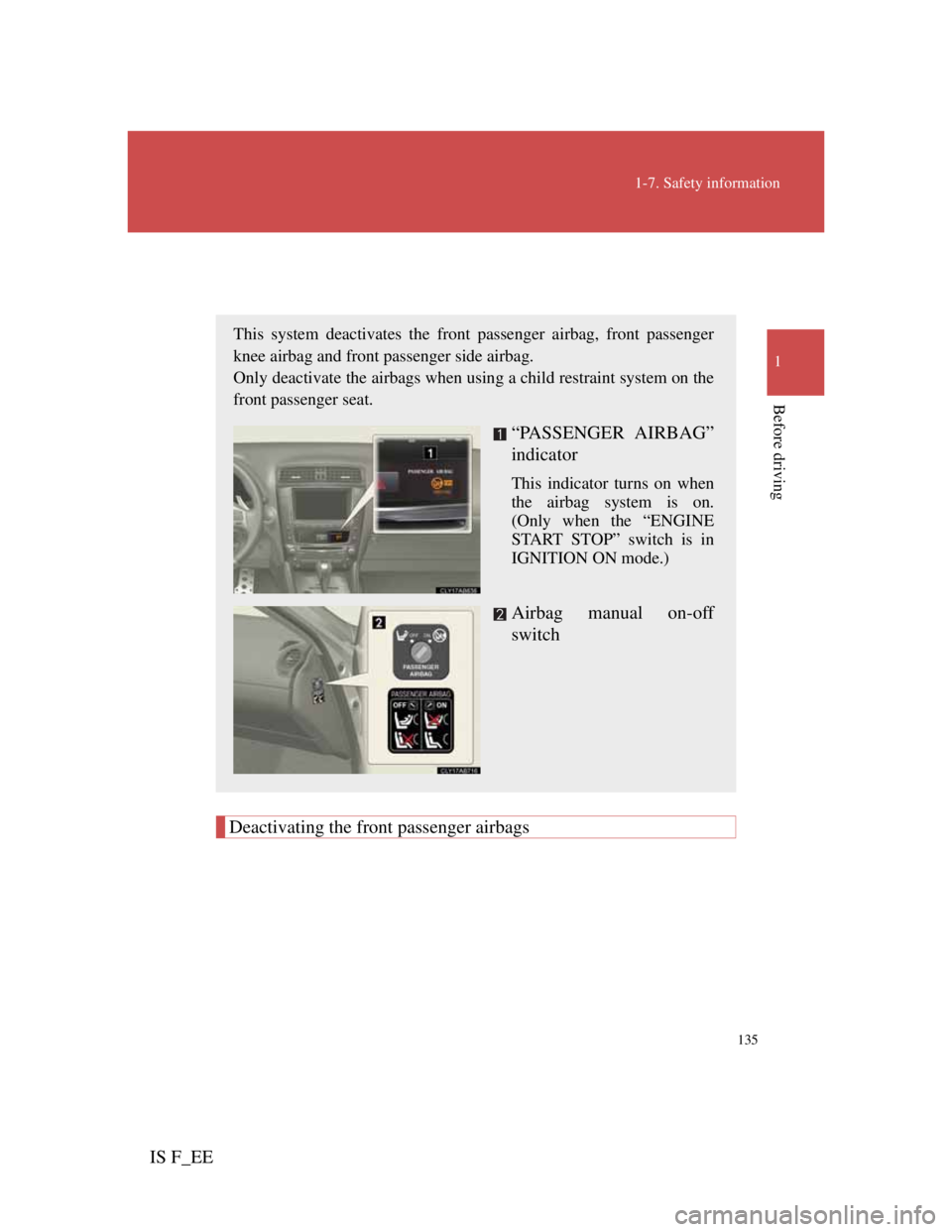
135
1-7. Safety information
1
Before driving
IS F_EE
Airbag manual on/off system
Deactivating the front passenger airbags
This system deactivates the front passenger airbag, front passenger
knee airbag and front passenger side airbag.
Only deactivate the airbags when using a child restraint system on the
front passenger seat.
“PASSENGER AIRBAG”
indicator
This indicator turns on when
the airbag system is on.
(Only when the “ENGINE
START STOP” switch is in
IGNITION ON mode.)
Airbag manual on-off
switch
Page 144 of 529
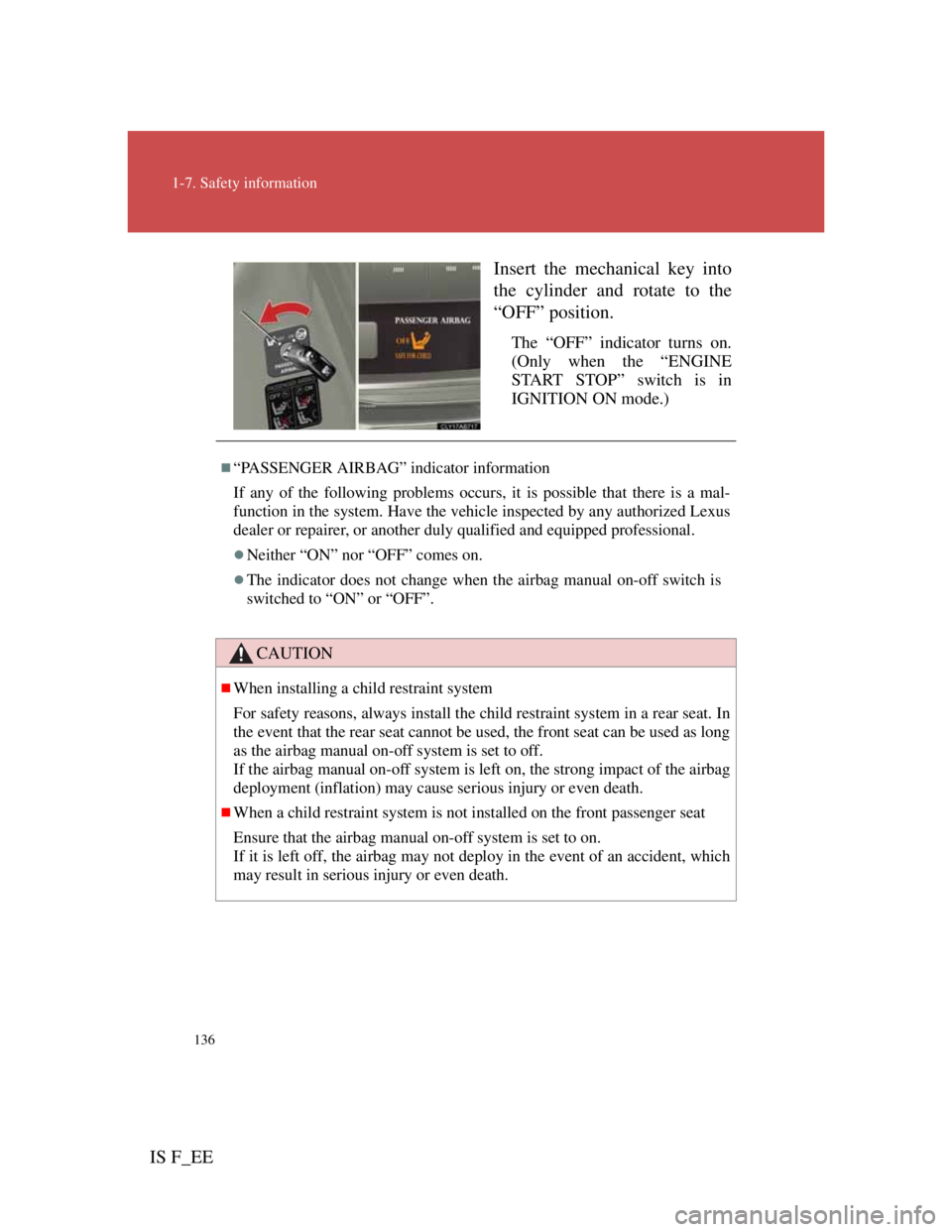
136
1-7. Safety information
IS F_EEInsert the mechanical key into
the cylinder and rotate to the
“OFF” position.
The “OFF” indicator turns on.
(Only when the “ENGINE
START STOP” switch is in
IGNITION ON mode.)
“PASSENGER AIRBAG” indicator information
If any of the following problems occurs, it is possible that there is a mal-
function in the system. Have the vehicle inspected by any authorized Lexus
dealer or repairer, or another duly qualified and equipped professional.
Neither “ON” nor “OFF” comes on.
The indicator does not change when the airbag manual on-off switch is
switched to “ON” or “OFF”.
CAUTION
When installing a child restraint system
For safety reasons, always install the child restraint system in a rear seat. In
the event that the rear seat cannot be used, the front seat can be used as long
as the airbag manual on-off system is set to off.
If the airbag manual on-off system is left on, the strong impact of the airbag
deployment (inflation) may cause serious injury or even death.
When a child restraint system is not installed on the front passenger seat
Ensure that the airbag manual on-off system is set to on.
If it is left off, the airbag may not deploy in the event of an accident, which
may result in serious injury or even death.
Page 145 of 529
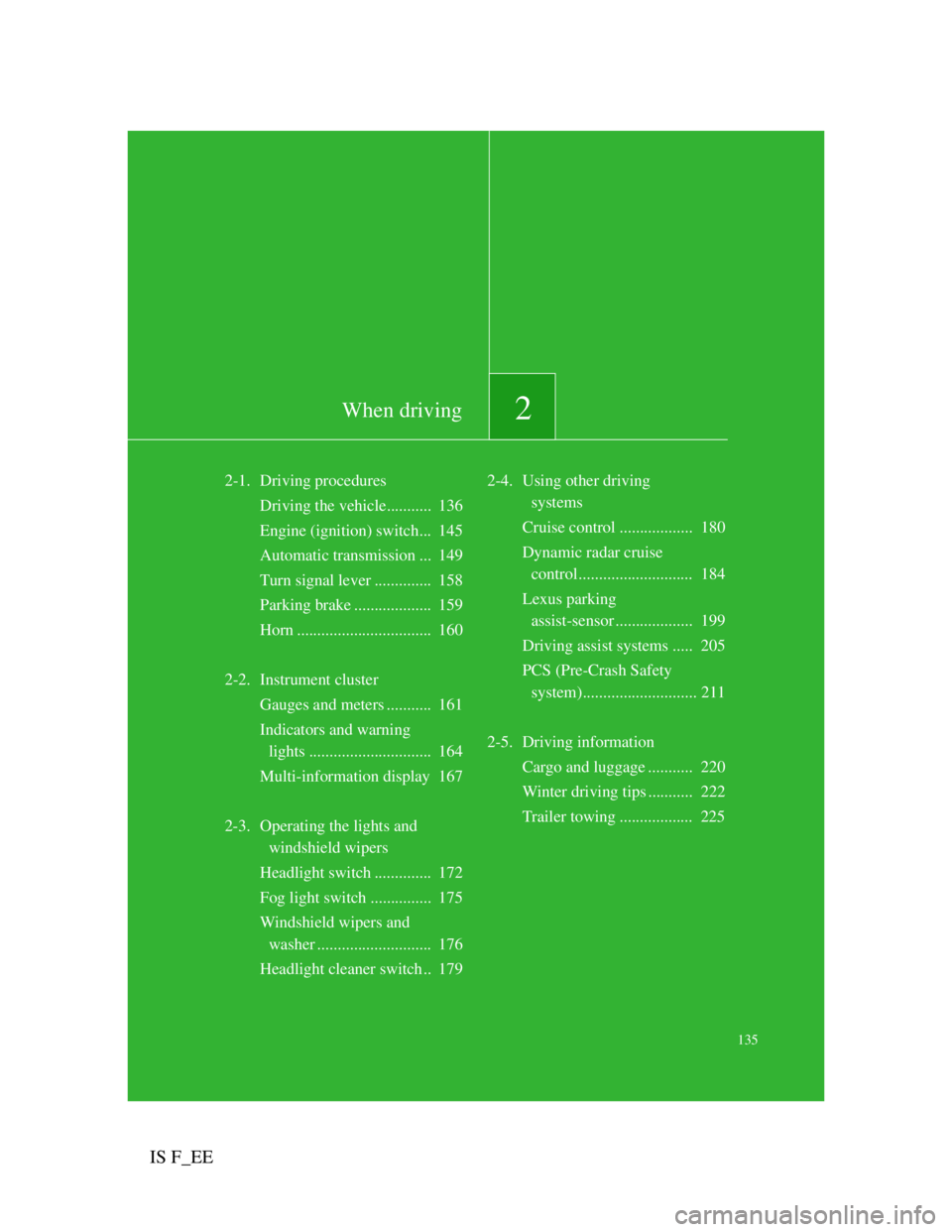
2When driving
135
IS F_EE
2-1. Driving procedures
Driving the vehicle........... 136
Engine (ignition) switch... 145
Automatic transmission ... 149
Turn signal lever .............. 158
Parking brake ................... 159
Horn ................................. 160
2-2. Instrument cluster
Gauges and meters ........... 161
Indicators and warning
lights .............................. 164
Multi-information display 167
2-3. Operating the lights and
windshield wipers
Headlight switch.............. 172
Fog light switch ............... 175
Windshield wipers and
washer ............................ 176
Headlight cleaner switch .. 1792-4. Using other driving
systems
Cruise control .................. 180
Dynamic radar cruise
control ............................ 184
Lexus parking
assist-sensor ................... 199
Driving assist systems ..... 205
PCS (Pre-Crash Safety
system)............................ 211
2-5. Driving information
Cargo and luggage ........... 220
Winter driving tips ........... 222
Trailer towing .................. 225
Page 147 of 529
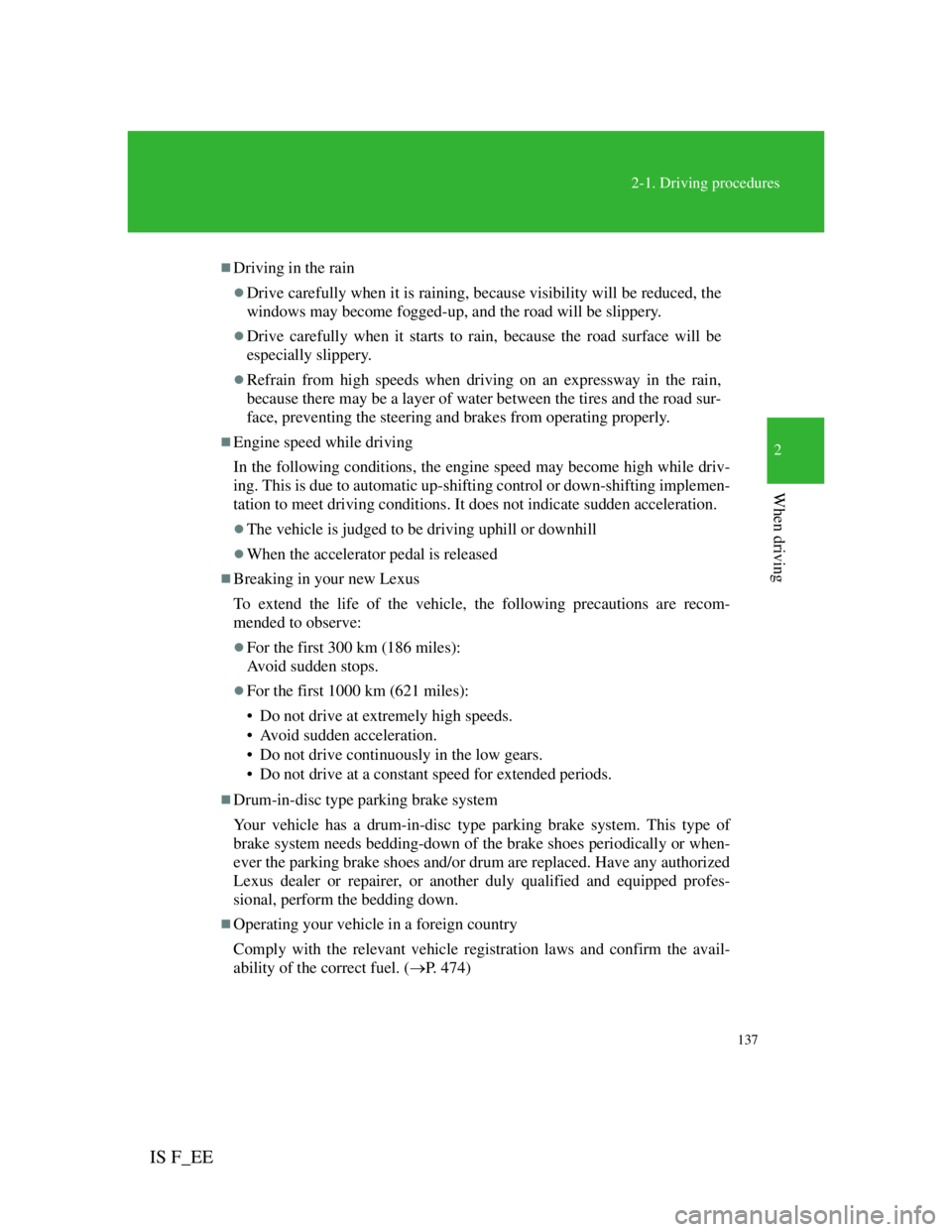
137
2-1. Driving procedures
2
When driving
IS F_EE
Driving in the rain
Drive carefully when it is raining, because visibility will be reduced, the
windows may become fogged-up, and the road will be slippery.
Drive carefully when it starts to rain, because the road surface will be
especially slippery.
Refrain from high speeds when driving on an expressway in the rain,
because there may be a layer of water between the tires and the road sur-
face, preventing the steering and brakes from operating properly.
Engine speed while driving
In the following conditions, the engine speed may become high while driv-
ing. This is due to automatic up-shifting control or down-shifting implemen-
tation to meet driving conditions. It does not indicate sudden acceleration.
The vehicle is judged to be driving uphill or downhill
When the accelerator pedal is released
Breaking in your new Lexus
To extend the life of the vehicle, the following precautions are recom-
mended to observe:
For the first 300 km (186 miles):
Avoid sudden stops.
For the first 1000 km (621 miles):
• Do not drive at extremely high speeds.
• Avoid sudden acceleration.
• Do not drive continuously in the low gears.
• Do not drive at a constant speed for extended periods.
Drum-in-disc type parking brake system
Your vehicle has a drum-in-disc type parking brake system. This type of
brake system needs bedding-down of the brake shoes periodically or when-
ever the parking brake shoes and/or drum are replaced. Have any authorized
Lexus dealer or repairer, or another duly qualified and equipped profes-
sional, perform the bedding down.
Operating your vehicle in a foreign country
Comply with the relevant vehicle registration laws and confirm the avail-
ability of the correct fuel. (P. 4 7 4 )
Page 151 of 529
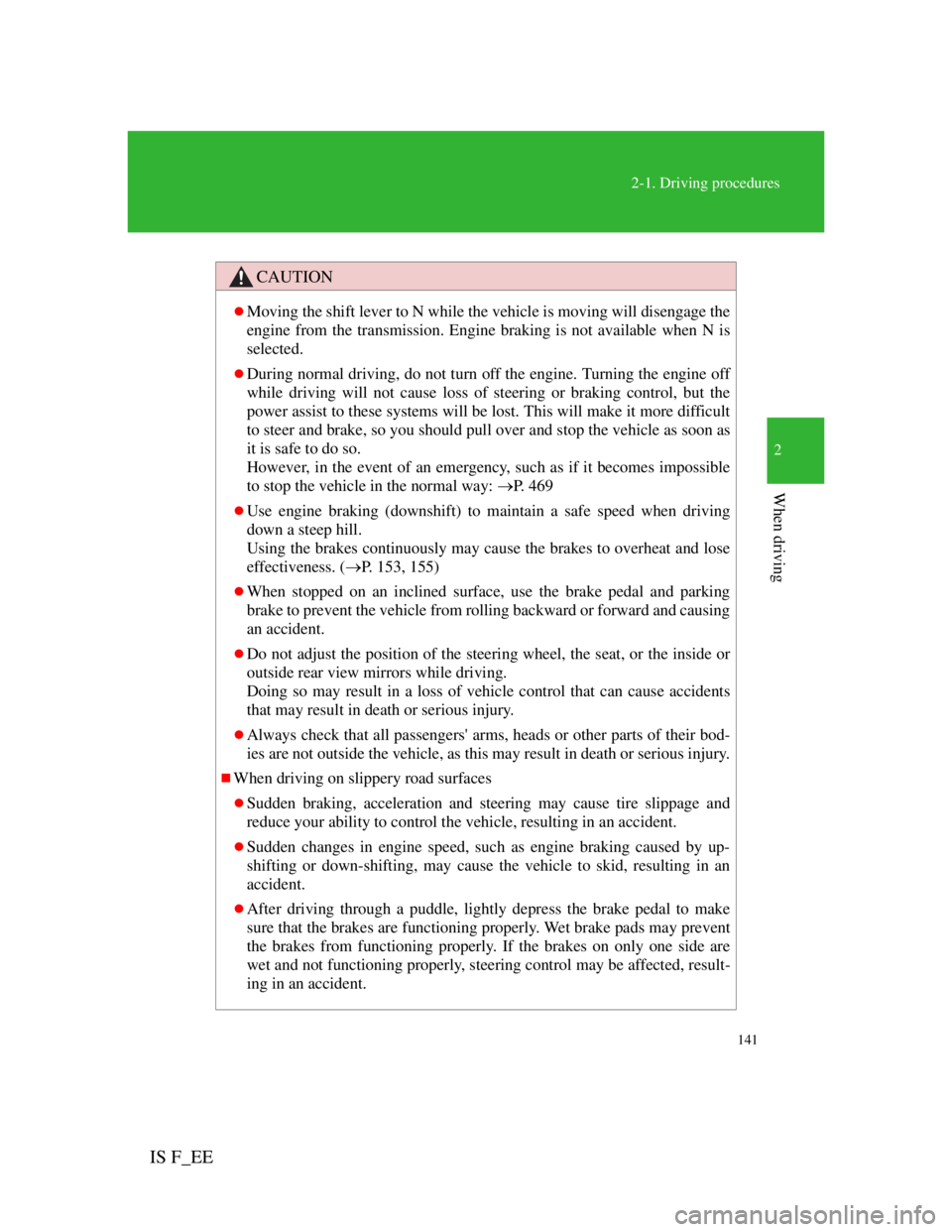
141
2-1. Driving procedures
2
When driving
IS F_EE
CAUTION
Moving the shift lever to N while the vehicle is moving will disengage the
engine from the transmission. Engine braking is not available when N is
selected.
During normal driving, do not turn off the engine. Turning the engine off
while driving will not cause loss of steering or braking control, but the
power assist to these systems will be lost. This will make it more difficult
to steer and brake, so you should pull over and stop the vehicle as soon as
it is safe to do so.
However, in the event of an emergency, such as if it becomes impossible
to stop the vehicle in the normal way: P. 4 6 9
Use engine braking (downshift) to maintain a safe speed when driving
down a steep hill.
Using the brakes continuously may cause the brakes to overheat and lose
effectiveness. (P. 153, 155)
When stopped on an inclined surface, use the brake pedal and parking
brake to prevent the vehicle from rolling backward or forward and causing
an accident.
Do not adjust the position of the steering wheel, the seat, or the inside or
outside rear view mirrors while driving.
Doing so may result in a loss of vehicle control that can cause accidents
that may result in death or serious injury.
Always check that all passengers' arms, heads or other parts of their bod-
ies are not outside the vehicle, as this may result in death or serious injury.
When driving on slippery road surfaces
Sudden braking, acceleration and steering may cause tire slippage and
reduce your ability to control the vehicle, resulting in an accident.
Sudden changes in engine speed, such as engine braking caused by up-
shifting or down-shifting, may cause the vehicle to skid, resulting in an
accident.
After driving through a puddle, lightly depress the brake pedal to make
sure that the brakes are functioning properly. Wet brake pads may prevent
the brakes from functioning properly. If the brakes on only one side are
wet and not functioning properly, steering control may be affected, result-
ing in an accident.
Page 152 of 529

142
2-1. Driving procedures
IS F_EE
CAUTION
When shifting the shift lever
Be careful not to shift the shift lever with the accelerator pedal depressed.
This may lead to unexpected rapid acceleration of the vehicle that may
cause an accident and result in death or serious injury.
If you hear a squealing or scraping noise (brake pad wear indicators)
Have the brake pads checked and replaced by any authorized Lexus dealer
or repairer, or another duly qualified and equipped professional, as soon as
possible.
Rotor damage can result if the pads are not replaced when needed.
Moderate levels of brake pad and disc wear allow enhanced front braking
power. As a result, the discs may wear more quickly than conventional
brake discs. Therefore, when replacing the brake pads, Lexus recommends
that you also have the thickness of the discs measured.
It is dangerous to drive the vehicle when the wear limits of the brake pads
and/or those of the brake discs are exceeded.
When the vehicle is stopped
Do not race the engine.
If the vehicle is in any gear other than P or N, the vehicle may accelerate
suddenly and unexpectedly, and may cause an accident.
Do not leave the vehicle with the engine running for a long time.
If such a situation cannot be avoided, park the vehicle in an open space
and check that exhaust fumes do not enter the vehicle interior.
In order to prevent accidents due to the vehicle rolling away, always keep
depressing the brake pedal while the engine is running, and apply the
parking brake as necessary.
If the vehicle is stopped on an incline, in order to prevent accidents caused
by the vehicle rolling forward or backward, always depress the brake
pedal and securely apply the parking brake as needed.
Avoid revving or racing the engine.
Running the engine at high speed while the vehicle is stopped may cause
the exhaust system to overheat, which could result in a fire if combustible
material is nearby.
Page 154 of 529

144
2-1. Driving procedures
IS F_EE
CAUTION
When taking a nap in the vehicle
Always turn the engine off. Otherwise, you may accidentally move the shift
lever or depress the accelerator pedal, which could cause an accident or fire
due to engine overheating. Additionally, if the vehicle is parked in a poorly
ventilated area, exhaust gases may collect and enter the vehicle, leading to
death or a serious health hazard.
When braking the vehicle
When the brakes are wet, drive more cautiously.
Braking distance increases when the brakes are wet, and may cause one
side of the vehicle to brake differently than the other side. Also the park-
ing brake may not securely hold the vehicle.
If the power brake assist function does not operate, do not follow other
vehicles closely and avoid downhills or sharp turns that require braking.
In this case, braking is still possible, but it will require more force on the
pedal than usual. Braking distance may also increase.
Do not pump the brake pedal if the engine stalls.
Each push on the brake pedal uses up the reserve for the power-assisted
brakes.
The brake system consists of 2 individual hydraulic systems: if one of the
systems fails, the other will still operate. In this case, the brake pedal
should be depressed more firmly than usual and braking distance becomes
longer.
Do not drive your vehicle with only a single brake system. Have your
brakes fixed immediately.
NOTICE
When driving the vehicle
Do not depress the accelerator and brake pedals at the same time during
driving. If the brake pedal is depressed while driving with the accelerator
pedal depressed, driving torque may be restrained.
Do not use the accelerator pedal or depress the accelerator and brake ped-
als together to hold the vehicle on a hill.
Page 157 of 529

147
2-1. Driving procedures
2
When driving
IS F_EE
Changing “ENGINE START STOP” switch mode
Modes can be changed by pressing the “ENGINE START
STOP” switch with the brake pedal released. (The mode changes
each time the switch is pressed.)
OFF
*
The emergency flashers can
be used.
ACCESSORY mode
Some electrical components
such as the audio system can
be used.
The “ENGINE START
STOP” switch indicator turns
amber.
IGNITION ON mode
All electrical components can
be used.
The “ENGINE START
STOP” switch indicator turns
amber.
*:If the shift lever is in a posi-
tion other than P when turning
off the engine, the “ENGINE
START STOP” switch will be
d